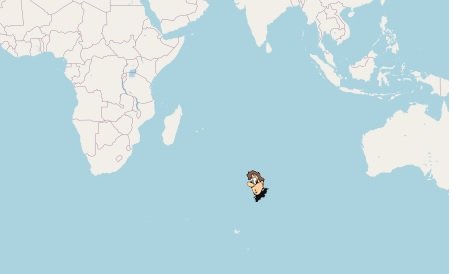hollydolly
SF VIP
- Location
- London England
Many a fruitless discussion has been had about where someone would end up if they began digging beneath them with the aim of coming out the other side.
In Britain, some might assume Australia, while for Americans the most popular answer would likely be China.
Although it is not physically possible to find out for sure – after all, it would require a journey of nearly 8,000 miles (12,870 km) through the Earth's crust, mantle and inner and outer core – an interactive map provides a theoretical way to check a location's opposite point.
It reveals that the majority of our planet's most populated cities have an opposite point, or 'antipode', somewhere in the ocean.
Of course, given that the surface of the Earth is around 71 per cent water, it is not surprising that the chances of hitting land are relatively low.
Cities that are nearly exact antipodes
Christchurch (New Zealand) and A Coruna (Spain)
Madrid (Spain) and Weber (New Zealand)
Wellington (New Zealand) and Alaejos (Spain)
Hong Kong (China) and La Quiaca (Argentina)
Nelson (New Zealand) and Mogadouro (Portugal)
Whangarei (New Zealand) and Tangier (Morocco)
Tauranga (New Zealand) and Jaen (Spain)
Hamilton (New Zealand) and Cordoba (Spain)
Junin (Argentina) and Lianyungang
Ulan Ude (Russia) and Puerto Natales (Chile)
Masterton (New Zealand) and Segovia
Palembang (Indonesia) and Neiva (Colombia)
Wuhai (China) and Valdivia (Chile)
Padang (Indonesia) and Esmeraldas (Ecuador)
Rafaela (Argentina) and Wuhu (China)
Galvez (Argentina) and Nanjing (China)
Major cities close to being antipodes
Auckland (New Zealand) and Seville & Malaga (Spain)
Xi'an (China) and Santiago (Chile)
Shanghai (China) and Buenos Aires (Argentina)
Beijing (China) and Bahia Blanca (Argentina)
Taipei (Taiwan) and Asuncion (Paraguay)
Bangkok (Thailand) & Phnom Penh (Cambodia) and Lima (Peru)
Montevideo (Uruguay) and Seoul (South Korea)
Bogota (Colombia) and Jakarta (Indonesia)
Suva (Fiji) and Timbuktu (Mali)
Melbourne & Canberra (Australia) and Azores (Portugal)
Manila (Philippines) and Cuiaba (Brazil)
Kuala Lumpur (Malaysia) and Cuenca (Ecuador)
Singapore and Quito (Ecuador)
Doha (Qatar) and Pitcairn Island (United Kingdom - Overseas Territory)
Antipodes Island (New Zealand) and Gatteville-le-Phare (France)
The majority of locations on land do not have land-based antipodes.'
The largest antipodal land masses are the Malay Archipelago, which is opposite the Amazon Basin and adjoining Andean ranges.
An American digging a hole from Times Square in New York would end up in the ocean off the coast of Australia, while Britons coming under the Houses of Parliament would reappear off the coast of New Zealand.
Russians digging from Moscow would find themselves in the middle of the Pacific.
And if you were in Tokyo and wanted to come out the other side of the Earth you'd be off the coast of Uruguay.
https://www.antipodesmap.com/#about-antipodes
In Britain, some might assume Australia, while for Americans the most popular answer would likely be China.
Although it is not physically possible to find out for sure – after all, it would require a journey of nearly 8,000 miles (12,870 km) through the Earth's crust, mantle and inner and outer core – an interactive map provides a theoretical way to check a location's opposite point.
It reveals that the majority of our planet's most populated cities have an opposite point, or 'antipode', somewhere in the ocean.
Of course, given that the surface of the Earth is around 71 per cent water, it is not surprising that the chances of hitting land are relatively low.
Cities that are nearly exact antipodes
Christchurch (New Zealand) and A Coruna (Spain)
Madrid (Spain) and Weber (New Zealand)
Wellington (New Zealand) and Alaejos (Spain)
Hong Kong (China) and La Quiaca (Argentina)
Nelson (New Zealand) and Mogadouro (Portugal)
Whangarei (New Zealand) and Tangier (Morocco)
Tauranga (New Zealand) and Jaen (Spain)
Hamilton (New Zealand) and Cordoba (Spain)
Junin (Argentina) and Lianyungang
Ulan Ude (Russia) and Puerto Natales (Chile)
Masterton (New Zealand) and Segovia
Palembang (Indonesia) and Neiva (Colombia)
Wuhai (China) and Valdivia (Chile)
Padang (Indonesia) and Esmeraldas (Ecuador)
Rafaela (Argentina) and Wuhu (China)
Galvez (Argentina) and Nanjing (China)
Major cities close to being antipodes
Auckland (New Zealand) and Seville & Malaga (Spain)
Xi'an (China) and Santiago (Chile)
Shanghai (China) and Buenos Aires (Argentina)
Beijing (China) and Bahia Blanca (Argentina)
Taipei (Taiwan) and Asuncion (Paraguay)
Bangkok (Thailand) & Phnom Penh (Cambodia) and Lima (Peru)
Montevideo (Uruguay) and Seoul (South Korea)
Bogota (Colombia) and Jakarta (Indonesia)
Suva (Fiji) and Timbuktu (Mali)
Melbourne & Canberra (Australia) and Azores (Portugal)
Manila (Philippines) and Cuiaba (Brazil)
Kuala Lumpur (Malaysia) and Cuenca (Ecuador)
Singapore and Quito (Ecuador)
Doha (Qatar) and Pitcairn Island (United Kingdom - Overseas Territory)
Antipodes Island (New Zealand) and Gatteville-le-Phare (France)
The majority of locations on land do not have land-based antipodes.'
The largest antipodal land masses are the Malay Archipelago, which is opposite the Amazon Basin and adjoining Andean ranges.
An American digging a hole from Times Square in New York would end up in the ocean off the coast of Australia, while Britons coming under the Houses of Parliament would reappear off the coast of New Zealand.
Russians digging from Moscow would find themselves in the middle of the Pacific.
And if you were in Tokyo and wanted to come out the other side of the Earth you'd be off the coast of Uruguay.
https://www.antipodesmap.com/#about-antipodes



